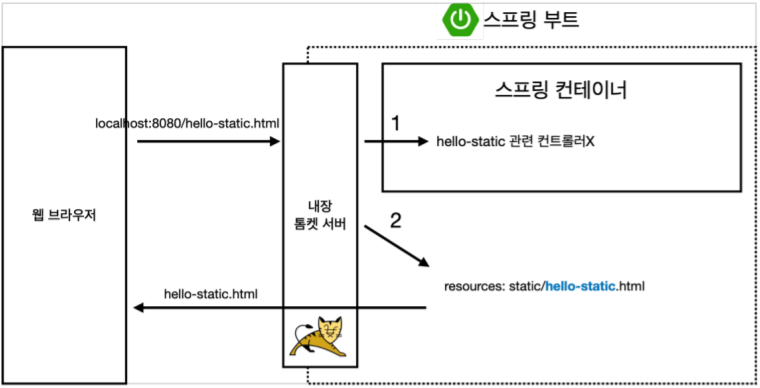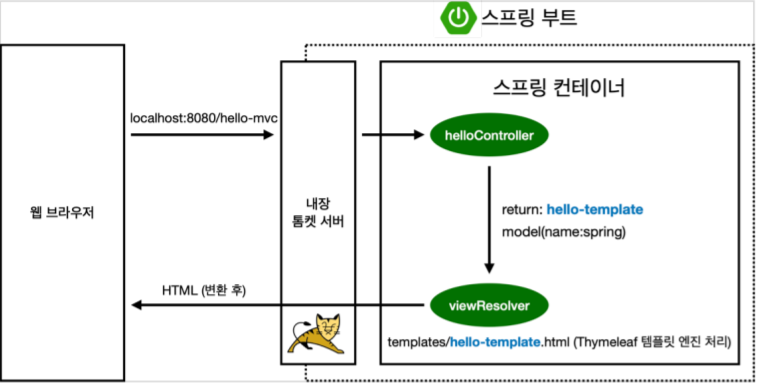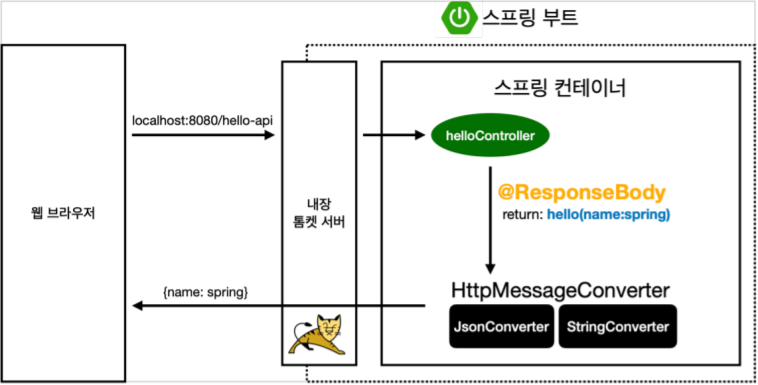스프링 웹 개발 기초
정적 컨텐츠
정적 컨텐츠는 html 파일을 그대로 웹브라우저에 띄우는 방식으로 앞서 실행 해봤던 welcome Page와 동작이 같다.
resource/static/hello-static.html을 생성하고 run해보자.
<!DOCTYPE HTML>
<html>
<head>
<title>static content</title>
<meta http-equiv="Content-Type" content="text/html; charset=UTF-8" />
</head>
<body>
정적 컨텐츠 입니다.
</body>
</html>
localhost:8080/hello-static.html로 접속해보면 출력되는걸 알 수 있다.
동작방식

웹 브라우저에서 요청 -> 톰켓 서버에서 요청 받음 -> spring한테 hello-static.html 알림
-> spring은 우선 컨트롤러에서 hello-static 컨트롤러를 확인 -> Mapping이 안되면 hello-static.html 파일을 찾고 웹 브라우저에 반환 -> 웹 브라우저는 html 출력
MVC
MVC는 Modle, View, Controller의 약자
- Model은 애플리케이션의 정보(데이터)
- View는 텍스트, 체크박스 항목 등과 같은 사용자 인터페이스 요소
- Controller는 데이터와 비즈니스 로직 사이의 상호동작을 관리
Controller 생성
src/main/java/hello.hellospring(폴더명이 다를 수 있음) 밑에 controller라는 폴더를 하나 생성 후, HelloController.java 파일을 생성하자.
@Controller
public class HelloController {
@GetMapping("hello-mvc")
public String helloMvc(@RequestParam("name") String name, Model model){
model.addAttribute("name",name);// key, value
return "hello-template";
}
}
@RequestParam(“가져올 데이터 이름”)[데이터 타입][데이터를 담을 변수] 형식으로 사용하면 된다.
이제 View의 역할을 할 resource/template 밑에 hello-templete.html도 생성하자.
<html xmlns:th="http://www.thymeleaf.org">
<body>
<p th:text="'hello ' + ${name}">hello! empty</p>
</body>
</html>
localhost:8080/hello-mvc?name=spring으로 접속해보면 hello empty에서 hello spring으로 바뀌는걸 볼 수 있다.
동작방식

웹 브라우저에서 요청 -> 톰켓 서버에서 요청 받고 스프링에게 전달 -> hello-mvc 컨트롤러 발견함 -> helloMVC 메소드에서 key는 name, value는 spring으로 모델을 만들어 viewResolver에게 전달 -> viewResolver는 return 값인 hello-template와 똑같은 이름을 가진 html파일을 찾아 변환 후 웹 브라우저에 반환 -> 웹 브라우저는 html 출력
MVC 장단점
- 장점
- 단순하고 직관적
- 각 구성 요소를 독립적으로 개발하기 때문에 효율적
- 단점
- View는 Model을 이용하기 때문에 의존성을 완벽히 분리 시킬수 없다.
- 코드가 복잡해질 가능성이 높고, 유지보수가 어렵다.
API
데이터 구조 포멧을 클라이언트에게 전달하는 방식. 클라이언트가 화면 구성을 하고 데이터는 api에서 가져오는 방식이나 서버간의 통신에서 주로 쓰인다. 기존에 생성했던 컨트롤러에 새로 코드를 추가하자.
@GetMapping("hello-string")
@ResponseBody // http body부분에 데이터를 직접 넣겠다는 의미
public String helloString(@RequestParam("name") String name) {
return "hello " + name;
}
이전에 사용했던 방식과 달리 view가 없고 hello name이라는 문자가 그대로 출력된다.
localhost:8080/hello-string?name=spring에 들어가면 볼 수 있다.
사실 이런 방법은 거의 안쓰고 아래의 방법을 자세히 보자.
역시 기존에 생성했던 컨트롤러에 새로 코드를 추가하자.
@GetMapping("hello-api")
@ResponseBody
public Hello helloApi(@RequestParam("name") String name){
Hello hello = new Hello();
hello.setName(name);
return hello;
}
static class Hello {
private String name;
public String getName() {
return name;
}
public void setName(String name) {
this.name = name;
}
}
localhost:8080/hello-api?name=spring에 접속하여 확인 할 수 있다. 그런데 api 처음 실행했던 결과와 다른 화면을 볼 수 있을것이다.
그 이유는 바로 Json으로 반환했기 때문이다.
동작방식

앞서 봤던 MVC의 방식과 거의 비슷하지만 스프링에서 처리 방법이 다르다.
viewResolver를 사용하지 않고 HttpMessageConverter가 동작한다.
- 기본 문자 처리: StringHttpConverter
- 기본 객체 처리: StrginJackSon2HttpMessageConverter
참고사항
- JackSon2는 객체를 Json 방식으로 변환해주는 라이브러리 버젼2를 의미한다.
- 스프링에 여러 format으로 변환 시키는 HttpMessageConverter가 기본적으로 탑재되어있고 깊이있게 들어가서 내가 원하는 format으로 변환할 수 있지만 강사님이 말하길 실무에서 거의 손대지않는다고 한다.
